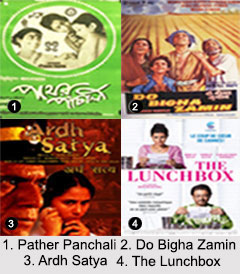 Art films in Indian Cinema occupy their own distinct space. Though commercial films are considered the prominent genre of mainstream Indian cinema, artistic films are laudable cinematic pieces that staunchly showcase reality which often pertains to prevalent social scenario, traditions and practices. Such films are thought provoking, appealing and convincing, leaving the audience with a question, a thought or a relevant idea in their minds. These films are collectively referred to as Parallel Cinema, also Indian Art Cinema or "New Indian Cinema" by film critics or also sometimes "the Indian New Wave".
Art films in Indian Cinema occupy their own distinct space. Though commercial films are considered the prominent genre of mainstream Indian cinema, artistic films are laudable cinematic pieces that staunchly showcase reality which often pertains to prevalent social scenario, traditions and practices. Such films are thought provoking, appealing and convincing, leaving the audience with a question, a thought or a relevant idea in their minds. These films are collectively referred to as Parallel Cinema, also Indian Art Cinema or "New Indian Cinema" by film critics or also sometimes "the Indian New Wave".From the 1960s through the 1980s, art films were usually government-aided and directors of such films received federal or state government grants to make non-commercial films on Indian themes. Their films were showcased at state film festivals and on government-run television networks. The films also had limited runs in art house theatres in India and overseas, portraying Indian realities inspired by foreign influences, like Italian Neo-Realism or French New Wave. Satyajit Ray was the most flourishing maker of such films, like The Apu Trilogy which comprised his most famed films ‘Pather Panchali’ (1955), ‘Aparajito’ (1956) and ‘Apur Sansar’ (1959).
Bimal Roy was another such prominent filmmaker. His ‘Do Bigha Zamin’ (1953) was one of those few productions that encompass both commercial and artistic elements. It went a critical and commercial success. Another filmmaker whose integrated art and commercial cinema was Guru Dutt, whose 1957 film ‘Pyaasa’ featured in Time magazine's "All-TIME" 100 best movies list. Among the other notable Hindi art films fall ‘Ankur’ (1974), Shyam Benegal’s first feature film where esteemed parallel cinema actress Shabana Azmi made her debut. Its plot is based on a true incident that occurred in Hyderabad, apparently in the 1950s. It won 3 National Film Awards and earned nomination for the Golden Bear at the 24th Berlin International Film Festival.
For more, visit the link below: